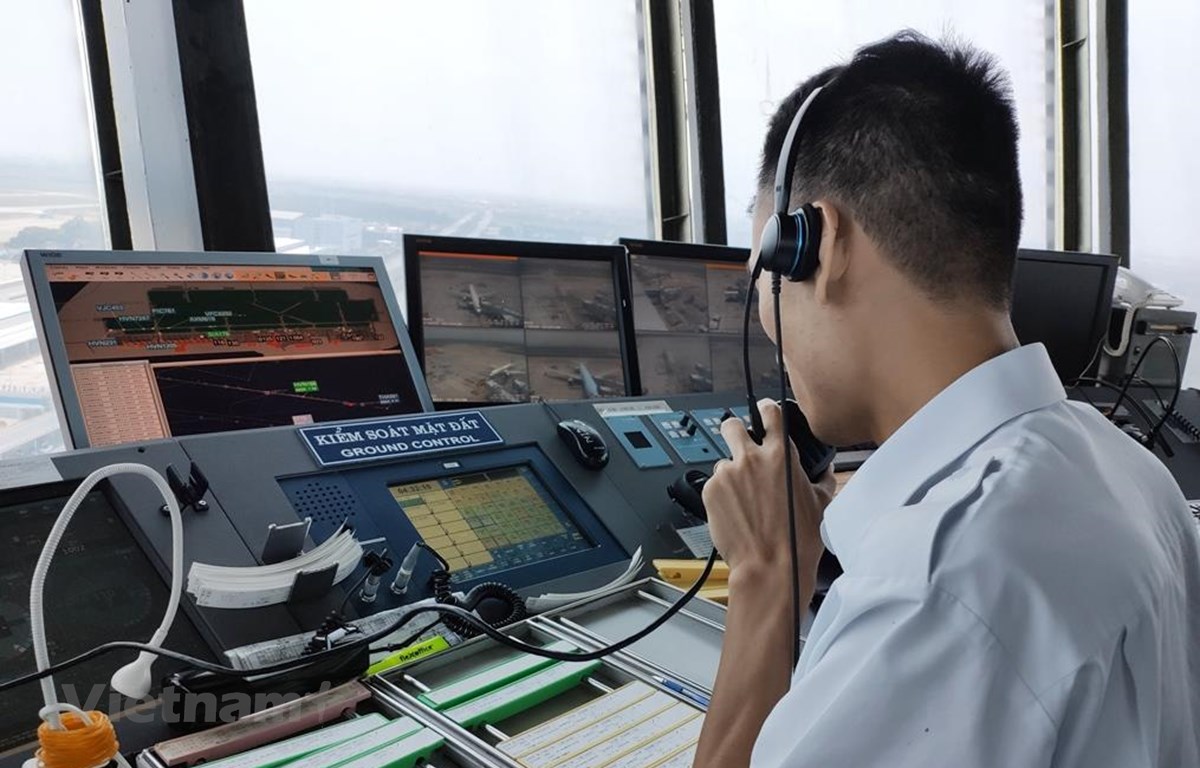Vietnam’s air traffic controllers face the strain with rising flights
HANOI — Already considered one of the most mentally challenging jobs, Vietnam’s air traffic controllers will be under even more pressure as passenger numbers rise.
The air traffic controllers are responsible for safe, orderly and expeditious flow of air traffic by organizing orders of airplanes and controlling their distances between each other when they take off and land at the airports.
The 88-meter-high Air Traffic Control Center building at Noi Bai International Airport in Hanoi, the tallest in Vietnam and Southeast Asia, is surrounded by glass where air traffic controllers can have a view of the runway and airplane parking area. They exchange flight information with pilots via radio to monitor position, speed and altitude of airplanes.
Nguyen Ngoc Quang, head of the Noi Bai Air Traffic Control Centre, said the airplanes are assigned to land in specific spaces to ensure distance between airplanes. The controllers will be notified if the airplanes land in the wrong area.
The minimum safe distance between two airplanes is five miles or 9.3 km.
Article continues after this advertisement“At Noi Bai Airport, the air space division is done very well, reducing landing waiting time,” Quang said.
Article continues after this advertisementTran Xuan Loc, deputy head of the center, said takeoff, landing and exchanges between air traffic controllers and pilots are recorded. If there is any mistake made by controllers or pilots, the records will be played to find who is responsible.
“To make sure pilots do not get the wrong orders, the air traffic controllers and pilots have to keep repeating what they want to say to each other,” Loc said.
Air traffic control is considered to be one of the most mentally challenging jobs in the world.
The center head Nguyen Ngoc Quang told vietnamplus.vn that one of the challenges is weather.
When the pilots face difficulties, the work of air traffic controllers is more challenging. Like police officers for the air, air traffic controllers must maintain safety.
In case of bad weather conditions, distances between airplanes must be increased. In case of storms or any incident on the runway or in urgent situations, air traffic controllers issue orders asking planes to wait.
Tran Hoang Linh, a female air traffic control at Noi Bai Airport, said the controllers usually face strenuous situations, for example, when planes are hit by birds or need security assistance. Air traffic controllers must be calm, determined and focused to offer support.
Concentrate
Besides highly specialized knowledge, skills and abilities, a ‘cool head’, calmness and determination, concentration and especially heath are what air traffic controllers need while on duty.
Lasting a maximum of two hours, the shift of an air traffic controller is strenuous and full of pressure. Any distractions or mistakes could result in the deaths of hundreds of passengers.
Before and after work, the controllers have their health checked.
They are not allowed to work if they are sick or experiencing psychological problems.
The work of air traffic controllers is more and more strenuous with the increasing number of flights. It is also an opportunity for them to improve their skills. The controllers at Noi Bai, Tan Son Nhat, Da Nang, Phu Bai, Cam Ranh and Cat Bi airports are more skilled than those of the other airports, said Quang.
On average, one flight departs or lands in HCM City every minute and one flight every two minutes from or to Hanoi. With such numbers, the capacity of Vietnamese air traffic controllers is similar to staff of any other country, Doan Huu Gia, general director of Vietnam Air Traffic Management Corporation (VATM), said.
According to the Civil Aviation Authority of Vietnam, air traffic controllers nationwide direct more than 750,000 flights every year.
The VATM currently has nearly 5,000 air traffic controllers working at air traffic control centers nationwide and directing more than 16,000 domestic and international flights every day.
According to Nguyen Ngoc Quang, it takes graduates a long time, about five years, for training before they can work independently. The graduates are trained at the flight management professional skill training centre and then continue to be trained at their workplace. Passing practice testing afterwards and being given a certificate is not enough, they must work under the supervision of a senior member of staff before being able to work independently.
All air traffic controllers must sit for a test by the International Civil Aviation Organization to be granted a certificate. Every year, they must attend 40 to 80 hours of training.
Once every year, the VATM tests air traffic controllers’ capacity to transfer unqualified officers to other work.
Gia said in spite of the strenuous workload, a lot of students apply for this major at the national entrance exam. According to Vietnam Aviation Institute, about 4,000 students applied in this year’s exam to compete for only 40 slots.
